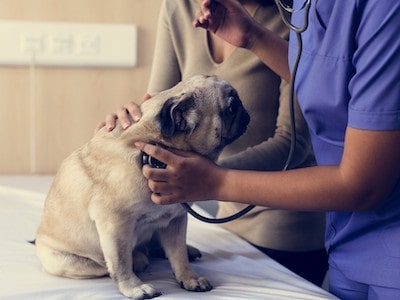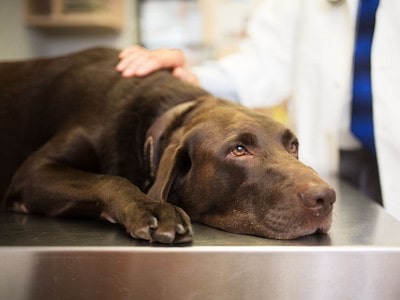Welcoming a new member into your family is always an exciting and joyous occasion. When it comes to our furry friends, the anticipation of adorable puppies brings an entirely different level of enthusiasm.
But before those tiny paws touch the ground, it’s essential for dog owners to understand the incredible journey of canine pregnancy.
In this comprehensive guide, we delve into the fascinating world of dog pregnancy, answering the burning question on every dog lover’s mind: “How long are dogs pregnant?”
From conception to birth, we’ll walk you through the stages of pregnancy, explore the signs and symptoms, and provide essential care tips for expectant canine mothers.
Whether you’re a seasoned breeder or a first-time pet parent, knowledge of the entire pregnancy process will enable you to be proactive, supportive, and well-prepared for the miraculous moment your beloved dog gives birth to her adorable litter.
So, let’s embark on this enlightening journey together and uncover the mysteries of canine pregnancy!
Contents
The Reproductive Cycle in Dogs
To understand how long dogs are pregnant, you need to know the reproductive cycle of female dogs. Female dogs go into heat approximately every six months, although this can vary depending on the breed and the individual dog.
According to Kathleen Claussen, DVM, from WebMD, “Smaller dogs can go into heat as soon as they are 4-months old. Larger breeds may not first go into heat until they are 18 to 24 months old. On average, the first heat begins at around 6 months of age.”
The heat cycle lasts 18-to-21 days and is divided into four stages: proestrus, estrus, diestrus, and anestrus.
Proestrus is the first stage of the heat cycle and lasts for about nine days. This is when female dogs start to attract male dogs, but they will reject their advances until the next stage. The signs of proestrus are swelling of the vulva and bloody discharge.

Estrus is the second stage of the heat cycle and lasts anywhere from three to 11 days. This is when female dogs are receptive to male dogs and can get pregnant.
Many breeders have a veterinarian take vaginal smears and blood tests during proestrus and estrus to determine the optimal time to breed their dogs.
The signs of estrus are a soft and enlarged vulva, lightening and decrease of discharge, and willingness to mate.
Diestrus is the third stage of the heat cycle and typically occurs around day 14. This is when female dogs are no longer receptive to male dogs and may be pregnant or not.
The signs of diestrus are reddening and tapering off of discharge, shrinking of vulva, and refusal to mate.
Anestrus is the fourth and final stage of the heat cycle and usually lasts around six months. This is when female dogs are not in heat and do not show any signs of reproductive activity.
Understanding the heat cycle can help you calculate the conception date of your dog, which in turn can help you estimate the due date of your dog’s pregnancy.
How to Tell if Your Dog Is Pregnant
Unlike humans, dogs don’t have the option of picking up a pregnancy test kit from the pharmacy, which means we have to rely on other methods to determine if a dog is pregnant.
Jean Laird,CVM, from A&M College states, “Some telltale signs to watch for in a pregnant pet are lethargy, not wanting to eat as much, not playing as much as usual and enlarged nipples,”
The most accurate way to tell if a dog is pregnant is through diagnostic testing by a veterinarian. However, there are also some signs and symptoms of dog pregnancy that you can observe at home, such as:

- Behavioral changes: Your dog may become more affectionate, clingy, or protective of you. She may also show signs of morning sickness, such as vomiting or loss of appetite, especially during the first few weeks of pregnancy.
- Appetite changes: Your dog may eat more or less than usual, depending on her stage of pregnancy and individual preferences. She may also develop cravings or aversions for certain foods.
- Weight gain: Your dog will gain weight gradually throughout her pregnancy, especially in the last few weeks when the puppies grow rapidly. You may notice her belly becoming bigger and rounder.
- Enlarged nipples: Your dog’s nipples will become larger, darker, and more prominent as her mammary glands prepare for lactation.
If you notice any of these signs in your dog, you should take her to the vet for a confirmation of pregnancy and a prenatal checkup. The vet can perform one or more of the following tests to determine if your dog is pregnant:
1) Palpation: If you know the date your dog was bred[1], your vet can perform abdominal palpation starting at approximately the 28-30-day mark.
At this stage in the pregnancy, the puppies feel like little golf balls or grapes depending on the size of the dog. These “balls” are fluid-filled sacks surrounding the fetus.
Abdominal palpation should not be attempted without the assistance of a vet, as it could damage the pups. The sacks lose their distinct shape after one month, so the timing of this test is important.
2) Ultrasound: Alternatively, your vet can do an ultrasound between 25 and 35 days of gestation. An ultrasound can usually detect fetal heartbeats, giving you an estimate of the number of puppies the bitch is carrying. Ultrasound can also reveal any abnormalities or complications in the pregnancy.
3) Hormone tests: Veterinarians can test for the hormone relaxin to determine if a bitch is pregnant. Relaxin is released from placental tissue only during pregnancy, which makes it a fairly accurate diagnostic test.
However, relaxin levels may not be detectable until 21-28 days after ovulation, so this test may not be useful for early detection.
4) X-ray: X-rays can be used to confirm pregnancy and count the number of puppies in the later stages of pregnancy, usually after 45 days. X-rays can also show the size and position of the puppies and identify any potential problems with delivery.
The Stages of Dog Pregnancy
Dog pregnancy can be divided into three trimesters, each lasting about 21 days or three weeks. During each trimester, different events and changes occur in your dog’s body and in her puppies’ development.
The first trimester is from day 0 to day 21 of pregnancy. During this trimester, the fertilized eggs travel to the uterine horn, where they implant themselves in the lining at about 15 to 18 days.
The embryos grow rapidly and double in size every seven days. By the end of the first trimester, a veterinarian can detect a fetal heartbeat and an ultrasound can show the shape of the puppies.

The second trimester is from day 22 to day 42 of pregnancy. During this trimester, the puppies’ organs and features develop and become more recognizable.
The puppies’ eyes, ears, nose, mouth, legs, and tail form. The puppies’ hair, nails, and teeth also start to grow. By the end of the second trimester, an x-ray can show the number and size of the puppies and their skeletons.
The third trimester is from day 43 to day 63 of pregnancy. During this trimester, the puppies gain weight and mature in preparation for birth. The puppies’ lungs, brain, and nervous system develop fully.
The puppies’ coat color and markings also become visible. By the end of the third trimester, the puppies are ready to be born.
Risks and Complications of Dog Pregnancy
Dog pregnancy is not without risks and complications[2]. Some of the common problems that can occur during dog pregnancy include:
1) Miscarriage: This is the loss of one or more puppies before they are viable. Miscarriage can happen at any stage of dog pregnancy, but it is more common in the first stage.
Some of the causes of miscarriage include genetic defects, infections, trauma, stress, or hormonal imbalances. Some of the signs of miscarriage include bleeding, abdominal pain, fever, or discharge from the vulva.
Tammy Hunter, DVM, from VCA Hospitals states, “If miscarriage is suspected, ultrasound is used to assess the pregnancy and determine whether the fetuses are alive.”
If you suspect your dog has had a miscarriage, you should take her to the veterinarian immediately for diagnosis and treatment.
2) Infection: This is the invasion of bacteria or other microorganisms into the uterus or other parts of the reproductive system. Infection can happen at any stage of dog pregnancy, but it is more common in the third stage.

Some of the causes of infection include poor hygiene, retained placenta, or injury during delivery. Some of the signs of infection include fever, lethargy, loss of appetite, foul-smelling discharge from the vulva, or mastitis (inflammation of the mammary glands).
If you notice any of these signs in your dog, you should take her to the veterinarian immediately for diagnosis and treatment.
3) Dystocia: This is the difficulty or inability to deliver one or more puppies. Dystocia can happen at any stage of dog pregnancy[3], but it is more common in the third stage.
Some of the causes of dystocia include large or malpositioned puppies, narrow pelvis, uterine inertia (weak contractions), or maternal exhaustion.
Some of the signs of dystocia include prolonged labor (more than four hours between puppies), excessive straining, green or black discharge from the vulva, or distress in the mother or the puppies.
If you observe any of these signs in your dog, you should take her to the veterinarian immediately for diagnosis and treatment.
The care and preparation for dog pregnancy
Dog pregnancy is a demanding and delicate period for your dog. Therefore, you should provide her with the best care and preparation possible to ensure her health and happiness. Some of the things you should do for your pregnant dog include:
A) Provide a healthy diet: Your pregnant dog needs a balanced and nutritious diet to support her growing puppies and her own body. You should feed her a high-quality commercial dog food that is specially formulated for pregnant or lactating dogs.
You should also increase her food intake gradually as her pregnancy progresses. You can divide her daily ration into several smaller meals to avoid overloading her stomach.
You should also provide her with fresh water at all times to keep her hydrated.

B) Provide moderate exercise: Your pregnant dog needs regular exercise to maintain her muscle tone, circulation, and digestion. You should take her for short walks every day, but avoid strenuous or vigorous activities that might cause stress or injury.
You should also avoid exposing her to extreme temperatures or humidity that might affect her breathing or thermoregulation.
C) Provide a comfortable environment: Your pregnant dog needs a calm and cozy environment to rest and relax. You should provide her with a soft and clean bedding that is large enough for her and her puppies.
You should also prepare a whelping box (a safe and enclosed area where she can give birth) in a quiet and familiar place in your home. You should line the whelping box with newspapers, towels, or blankets that can be easily changed after delivery.
You should also keep the whelping box away from drafts, noise, or other pets that might disturb your dog.
D) Provide veterinary support: Your pregnant dog needs regular veterinary check-ups to monitor her health and progress. You should take her to the veterinarian at least once a month during her pregnancy.
Your veterinarian can perform various tests and procedures to confirm the pregnancy, estimate the litter size, detect any problems, and advise you
FAQs
What should I feed my pregnant dog?
During pregnancy, your dog’s nutritional needs change significantly. High-quality, balanced dog food formulated for pregnant or nursing dogs is essential. Consult your veterinarian to ensure you’re providing the right nutrients and caloric intake for a healthy pregnancy and the development of the growing puppies.
How can I prepare for my dog’s delivery?
What should I feed my pregnant dog?
During pregnancy, your dog’s nutritional needs change significantly. High-quality, balanced dog food formulated for pregnant or nursing dogs is essential. Consult your veterinarian to ensure you’re providing the right nutrients and caloric intake for a healthy pregnancy and the development of the growing puppies.
Can I breed my dog during her first heat cycle?
It is generally recommended to wait until a dog has reached physical and mental maturity before considering breeding. Breeding during the first heat cycle is generally discouraged because the dog is still growing and might not be fully prepared for motherhood.
When should I be concerned during my dog’s pregnancy?
If your dog exhibits any signs of distress, discomfort, or unusual symptoms during her pregnancy, consult your veterinarian immediately. Signs like prolonged labor, fever, loss of appetite, or significant behavioral changes warrant immediate attention.
Well, That’s a Wrap
Dogs are pregnant for about 63 days or nine weeks on average. However, the duration of dog pregnancy can vary depending on several factors, such as breed, litter size, and date of conception.
To find out if your dog is pregnant and how many puppies she is carrying, you should consult a veterinarian and use one of the diagnostic methods available.
To ensure a healthy and successful delivery, you should know the stages of dog pregnancy and labor and prepare a whelping box and a whelping kit beforehand.
To care for your pregnant dog and her puppies, you should provide proper nutrition, exercise, rest, and prenatal checkups. You should also contact a veterinarian if you notice any signs of complications or distress.
Reference:
- Capilé, K., Campos, G. M. B., Stedile, R., & De Oliveira, S. T. (2015). Canine Prostate Palpation Simulator as a teaching tool in veterinary education. Journal of Veterinary Medical Education, 42(2), 146–150. AAVMC
- Staff, A. (2021). Steps to prevent pregnancy problems in bitches. American Kennel Club.
- Pretzer, S. (2008). Medical management of canine and feline dystocia. Theriogenology, 70(3), 332–336. Science Direct

A retired veterinary technician and full-time dog parent. James knows to serve the community with the best of his knowledge of animal healthcare. He has been working in a known veterinary clinic for quite a few years. He loves reading blogs on pet nutrition and writes unbiased reviews of dog products.


